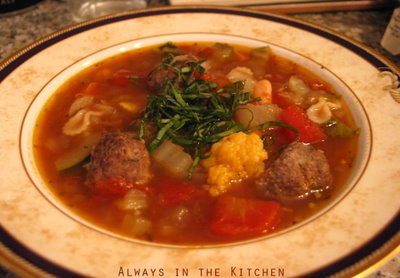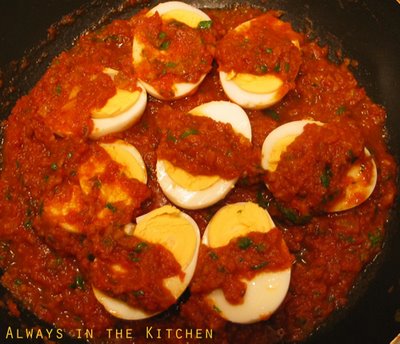
I love soup. I cannot think of a culture that does not have some sort of soup. It can be an eloquent, evocative way to capture a sense of a particular cuisine, or a memory of a place. It can also be a tasty repository for things lurking in the refrigerator, slowly measuring their last useful gasps of usability until metamorphosis turns them into - if neglected, well, sludge, but if lovingly tended - a warming, welcoming breakfast (think
menudo), lunch, or dinner.
As someone who grew up with "heirloom soup" in the winter, an ever-evolving pot of plenty into which most leftovers eventually found their way, I've always thought as soup as a somewhat ambiguous term, and was amused by people who made "mushroom soup" or "barley soup" because at any given time there might be mushrooms or barley or both in the heirloom soup. Even a soup that started off quite specific - chicken noodle, or oxtail, perhaps - would mutate quickly and, I thought, inevitably. As I grew older, I began to have an appreciation for the carefully thought out soups that highlighted a particular item. I've always had a fondness for minestrone, which somewhat bridges the gulf between the two philosophies of soup.
People will tell you that there are very particular things that one needs to put in (or omit from) a "true" minestrone, but these things vary by region and are often contradictory. Many minestrones are vegetarian, using plain water as the cooking medium instead of stock, and deepning the overall flavour with a rind of parmesan, and others will start with pancetta or bacon, and move on to a chicken broth. To achieve this particular minestrone, I went with a fairly classic approach, chose from the "acceptable" vegetables (since I had them on hand) and then spoiled it all by adding beef meatballs at the end. I'm not a bit sorry - the whole thing turned out just as I wanted.
Meatball Minestrone
2 tablespoons olive oil (or duck fat)
1 large onion, diced
3 cloves garlic, minced
1 fennel bulb, diced medium-small
2 carrots, diced
1 small zucchini, diced (about 1 1/2 cups)
2 stalks of celery, chopped
1 cup of small cauliflower florets
8 cups water or vegetable stock
1 28 oz. can of diced tomatoes
1 15 oz. can of cannellini beans, with liquid
1/4 cup tripolini or other small soup pasta
1/2 teaspoon dried oregano leaves
1/2 teaspoon dried basil leaves
white pepper
salt to taste
small, cooked meatballs from 1 pound of ground meat (I bake mine in the oven for 25 minutes, rather than frying them)
In a large soup pot or dutch oven, heat your olive oil over medium-high heat. Add onion, garlic, fennel, carrots and celery, and stir well. Season with a little salt and white pepper, and stir for a few minutes until the vegetables begin to go translucent.
Stir in the water/stock, tomatoes (with their juices), zucchini, cauliflower, and herbs to taste. bring to a boil, reduce heat and simmer gently, covered, for about 30 minutes.
Stir in the cannelini beans with their liquid, and the pasta. Simmer for an additional 10 minutes or until the pasta is al dente and beans are heated through. Add meatballs and stir through. Adjust for salt and pepper to taste before serving, and garnish each bowl with some fresh basil or a a dollop of basil pesto.
 I love the food at Christmastime. Maybe it's the stuffing. Maybe it's that we eat four times as much cheese as usual. Maybe it's the chocolate, or maybe it's just that there are a lot of food-centric gatherings of friends and family. However, when the decorations come down, it's time for something other than the Northern European food that I have been devouring over the past month.
I love the food at Christmastime. Maybe it's the stuffing. Maybe it's that we eat four times as much cheese as usual. Maybe it's the chocolate, or maybe it's just that there are a lot of food-centric gatherings of friends and family. However, when the decorations come down, it's time for something other than the Northern European food that I have been devouring over the past month. I've cooked red rice once before, and I'm pretty sure that I will again. It has a firmer bite to it than white rice, and a nuttier taste than most brown rices. It looks pretty on the plate - not the purply colour of Forbidden Rice, but a lovely sort of warm, dark red that would look really good in a shoe (ahem).
I've cooked red rice once before, and I'm pretty sure that I will again. It has a firmer bite to it than white rice, and a nuttier taste than most brown rices. It looks pretty on the plate - not the purply colour of Forbidden Rice, but a lovely sort of warm, dark red that would look really good in a shoe (ahem).























